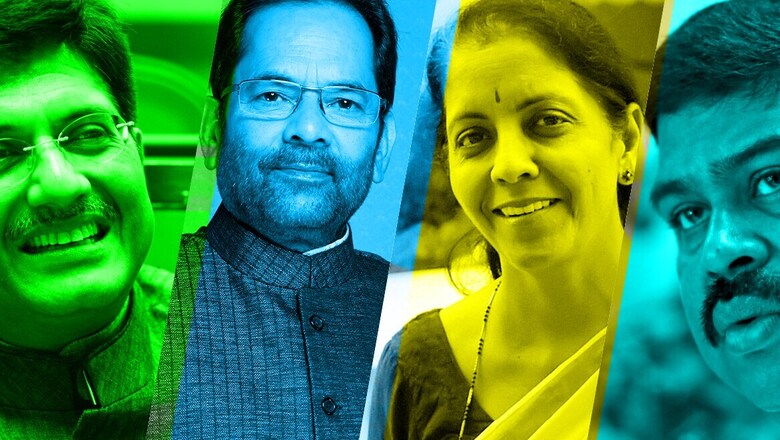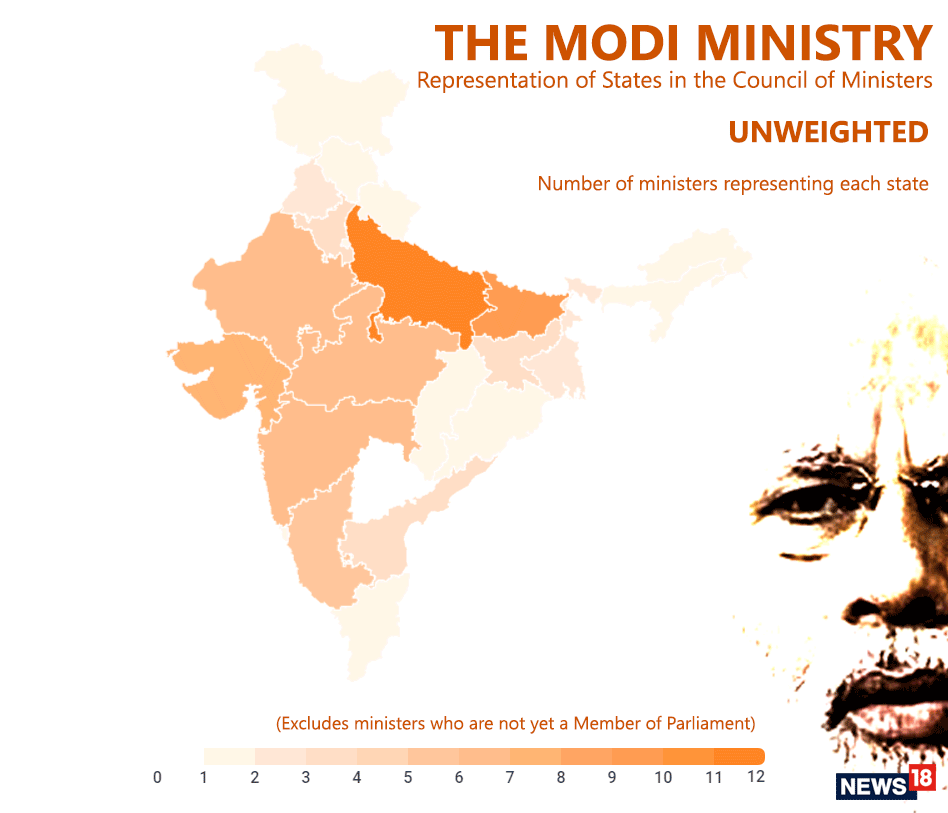
views
New Delhi: Modi’s government’s third cabinet reshuffle, in the last three years, saw some big surprises.
Handing Nirmala Sitharaman the defence ministry can be safely put on top. Sitharaman, an alumni of JNU, will be the first woman full-time defence minister. In an exclusive interview to CNN News18, Sitharaman said she was looking forward to addressing the gender imbalance in the forces.
Sitharaman took over the charge from Arun Jaitley, who retained finance ministry and corporate affairs. Responding to opposition charges that too many bureaucrats had been given cabinet posts, he called Manmohan Singh a quasi-bureaucrat.
One of the other highlights of the reshuffle was the appointment of former Olympian Rajyavardhan Rathore as sports minister, making him the first sportsman to have headed the ministry.
Shortly after announcing the porfolios, Modi left for a 5-day, 2-nation trip to China and Myanmar, throwing into the spotlight his habit of embarking on foreign trips right after major national announcements.
If the Union cabinet reshuffle on Sunday has anything to do with the BJP’s Mission 2019, it is not yet evident. The exercise sends all kinds of messages other than what was expected; that it will indicate, substantially, the Narendra Modi-Amit Shah strategy for the next general elections.
WHAT IT MEANS POLITICALLY
The clear indication as on date is that the reshuffle is only the first in a series of future rejigs before the party actually sits down to thrash its electoral strategy.
But if it is seen in larger, electoral perspective, the exercise throws up a few links which may seem unconnected right away, but certainly are part of the BJP’s long-term strategy.
Why former bureaucrats, that too four of them, were chosen is best known to the Prime Minister. A reasonable speculation about one of them, Alphons Kannanthanam, could be that the BJP hopes to woo the Church in God’s own country. He is known as the IAS officer who made Kottayam – also his native district – the country’s first 100% literate town in 1989. The Syrian Christian, once a Left-supported MLA, joined the BJP in 2011.
The five others who took oath are all BJP MPs. They share some common characteristics. Either they are all seasoned parliamentarians, having won Lok Sabha elections many number of times, or they have links to the RSS. Anant Kumar Hegde of Karnataka is a five-time MP. He represents the harsher shade of Hindutva in his area. An RSS and ABVP activist, his hard stance on communal issues determined his rise within the BJP since 1992.
Ashwini Choubey is a seasoned RSS and BJP leader from Bihar who perhaps is respected by the Prime Minister. He was the “junior” Choubey of Bihar BJP. The senior was Lalmuni Chaubey, the giant Brahmin leader who won from Buxar Lok Sabha for consecutive times from 1996. In 2009, he lost narrowly to RJD’s stalwart, Jagadanand Singh, by over 2000 votes.
In 2014, the BJP ignored him and gave the ticket to Ashwini Choubey. Lalmuni quit the party, but the Modi wave ensured the “junior” Choubey’s victory in this Brahmin-dominant constituency. Interestingly, Buxar and Varanasi – Modi’s constituency – are next to each other. Varanasi in Uttar Pradesh ends where Buxar in Bihar begins. Set on the banks of the Ganga, both constituencies are dominated by Kanyakubja and Saryupareen Brahmins and are holy places to boot.
Virendra Kumar from Madhya Pradesh is a formidable BJP leader, having won thrice from Sagar and twice from Tikamgarh. Former Uttar Pradesh minister Shiv Pratap Shukla is a veteran legislator. Gajendra Singh Shekhawat is a social-media savvy leader with RSS roots. The Jodhpur MP won with a record 4.10 lakh margin. He has links to the Swadeshi Jagran Manch and the BJP Kisan Morcha.
Does all this explain Mission 2019?
Not entirely. It reflects an upper caste, especially Brahmin, tilt. Most of them have RSS backgrounds. Essentially, it is all about balancing out things in north Indian states like Rajasthan, which is going to elections in 2018.
Like Uttar Pradesh, where the heavy Rajput presence – CM Yogi Adityanath and Home Minister Rajnath Singh – is balanced by the entry of Shiv Pratap Shukla into the Union council. A Union minister Mahendra Nath Pandey was sent to UP as BJP chief. Satyapal Singh the Jat brings up the western UP equation.
Like Bihar, where the BJP feels the next election will be a straight affair between itself and the RJD – the upper castes were treated to some ministerial cakes – Choubey from Brahmin-strong Buxar and RK Singh from Rajput-strong Arrah (he hails from Supaul, formerly part of Saharsa district in north-eastern Bihar with a decent Thakur population).
The unfinished tasks for the BJP’s Mission 2019 are still unfinished. One is satisfying the alliance partners. The Sunday reshuffle was entirely a BJP affair. The allies are not exactly making BJP’s job easy. JDU’s Nitish Kumar was apparently not satisfied by the reported offer of one berth – that of a minister of state with independent charge. Nitish is said to have been wanting to send Santosh Kushwaha from the Lok Sabha and Ramchandra Prasad Singh from Rajya Sabha into the Union council.
That was not to be because of reported pressure from Shiv Sena and Telugu Desam Party who have more MPs in the Lok Sabha than JDU. In the event, many of the allies kept away from Sunday’s reshuffle. This needs immediate sorting.

The second is that it is not wrong if the lay man feels the reshuffle seems a non-South Indian affair. It is. It focuses on the Hindu heartland, once known as the Bimaru states of Bihar, Rajasthan and Uttar Pradesh. The original political playground of the BJP before it became an an-India party.
Anti-incumbency in Rajasthan, under-a-cloud secular credentials of Yogi and his ministers in UP, the non-weakening RJD of Lalu Yadav in Bihar – these factors are keeping the BJP busy. Does this indicate something politically significant? Let’s put it in a safe way: The BJP is trying to consolidate its position in the Hindi-speaking big states, while it will have to focus on the real trouble – South India.
There are 132 Lok Sabha seats in the south. But the number of them in the Modi council is in single digits. Most of them are from Karnataka which returned 17 MPs. There’s one from Kerala now, a former IAS officer.
There are two from Andhra, one of them cabinet rank. But both are from ally TDP. None of the two BJP MPs is a minister. Why? No idea. A funny thing doing the rounds is that BJP MP from Visakhapatnam, K Hari Bab, was convinced he was going to take oath as a minister on Sunday. He even made his preparations for the event, but in vain. Tamil Nadu has one. He is also the lone BJP MP. Telangana has none after Bandaru Dattatreya was asked to go. He was the lone BJP MP.
This is understandable. For, in contrast, in 2011, there were 25 ministers from the South in UPA-II. Home, defence and external affairs were with South Indian MPs. The Congress won 59 seats from the south while the DMK had 18. The UPA had 113 members out of 188 from south India, representing both Houses of Parliament.
Till Venkiah Naidu was present in Delhi – for nine years during Vajpayee’s and Modi’s years – he was a prominent minister and even BJP president. But party leaders in both Andhra and Telangana claim Naidu never allowed the growth of other leaders. The TDP is the BJP ally in Andhra Pradesh and TRS in Telangana is not exactly a BJP adversary despite its dependence on Muslim votes. But like the late Jayalalithaa, these two regional leaders – Chandra Babu Naidu and K. Chandrasekhara Rao – would not want their influence diminished by encouraging the BJP.
Tamil Nadu is a political cauldron with nothing making sense to the BJP except for that fact that even though it is trying to monitor the goings-on in the AIADMK, it still has a long way to go. Even if the BJP were to have some alliance with a Tamil grouping, whether that will help it actually win seats is something to be seen. Karnataka is the BJP’s best bet, though the Congress is trying everything to snuff out the competition. Kerala is still in the exploratory stage. In this kind of a situation, why would the BJP invest in a larger representation to the south in the Union council?
In this kind of a scenario, the Sunday reshuffle is but an elementary step towards Mission 2019, with the bigger and more important steps still taking shape. After all, it has been India’s electoral experience that the configuration of a Union council of ministers never really mattered in the general elections. Brands alone mattered. Brands like Modi, Vajpayee, Indira Gandhi. Their parties did not win elections because of their ministers. They won or lost on the basis of their own image.

















Comments
0 comment